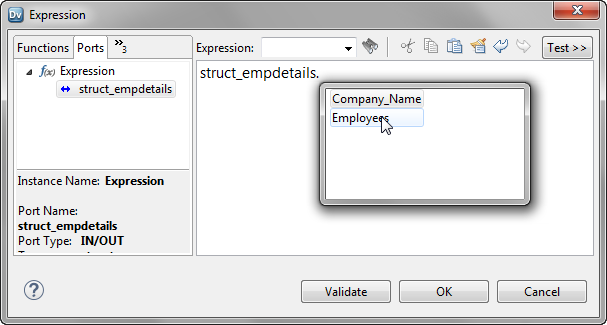Complex Operators
A complex operator is a type of operator to access elements in a complex data type. The transformation language includes complex operators for complex data types. Use complex operators to access or extract elements in hierarchical data.
The following table lists the complex operators:
Complex Operators | Description |
|---|
[] | Subscript operator. Use to access array and map elements. Syntax: array[index] - - array is the array from which you want to access an element.
- - index is the position of an element within an array.
For example, use [0] to access the first element in an one-dimensional array. Syntax: map[key] - - map is the map from which you want to access the value corresponding to a key.
- - key is the map key for which you want to retrieve the map value.
|
. | Dot operator. Use to access struct elements. Syntax: struct.element_name - - struct is the struct from which you want to access an element.
- - element_name is the name of the struct element.
|
Use complex operators in expressions to convert hierarchical data to relational data.
For more information about the operator syntax, return values, and examples, see the Informatica Developer Transformation Language Reference.
Complex Operator Examples
- •Convert array data in a JSON file to relational data.
A JSON file has a quarterly_sales column that is of the array type with integer elements. You develop a mapping to transform the hierarchical data to relational data. The array port quarterly_sales contains four elements. Use subscript operators in expressions to extract the four elements into the four integer ports, q1_sales, q2_sales, q3_sales, and q4_sales.
The expressions for the integer output port are as follows:
quarterly_sales[0]
quarterly_sales[1]
quarterly_sales[2]
quarterly_sales[3]
- •Convert struct data in a Parquet file to relational data.
A Parquet file has an address column that contains customer address as a struct type. You develop a mapping to transform hierarchical data to relational data. The struct port address contains three elements city, state, and zip, of type string. Use dot operators in expressions to extract the three struct elements into the three string ports, city, state, and zip.
The expressions for the string output port are as follows:
address.city
address.state
address.zip
Extracting an Array Element Using a Subscript Operator
Use the subscript operator in expressions to extract one or more elements of an array.
1. In the transformation, create an output port of the same data type as the return value of the array element that you want to extract.
To extract more than one element in an array, create an array output port. The data type of the elements in the type configuration for the array port must match the data type of the return value of the array elements.
2. In the Expression column for the output port, click the Open button.
The Expression Editor opens.
3. Delete the existing expression in the editor.
4. Click the Ports tab and select an array port.
5. Enter one or more index values within the subscript operator.
To extract array elements in a multidimensional array, enter index values within each subscript operator.
6. Click Validate to validate the expression.
7. Click OK to exit the Validate Expression dialog box.
8. Click OK to exit the Expression Editor.
Extracting a Struct Element Using the Dot Operator
Use the dot operator in expressions to extract elements of a struct.
1. In the transformation, create an output port of the same data type as the return value of the struct element that you want to extract.
2. In the Expression column for the output port, click the Open button.
The Expression Editor opens.
3. Delete the existing expression in the editor.
4. Click the Ports tab and select the struct port.
5. Enter a dot after the port name.
The Developer tool displays a list of elements in the struct.
6. Select the element that you want to extract.
7. Click Validate to validate the expression.
8. Click OK to exit the Validate Expression dialog box.
9. Click OK to exit the Expression Editor.
